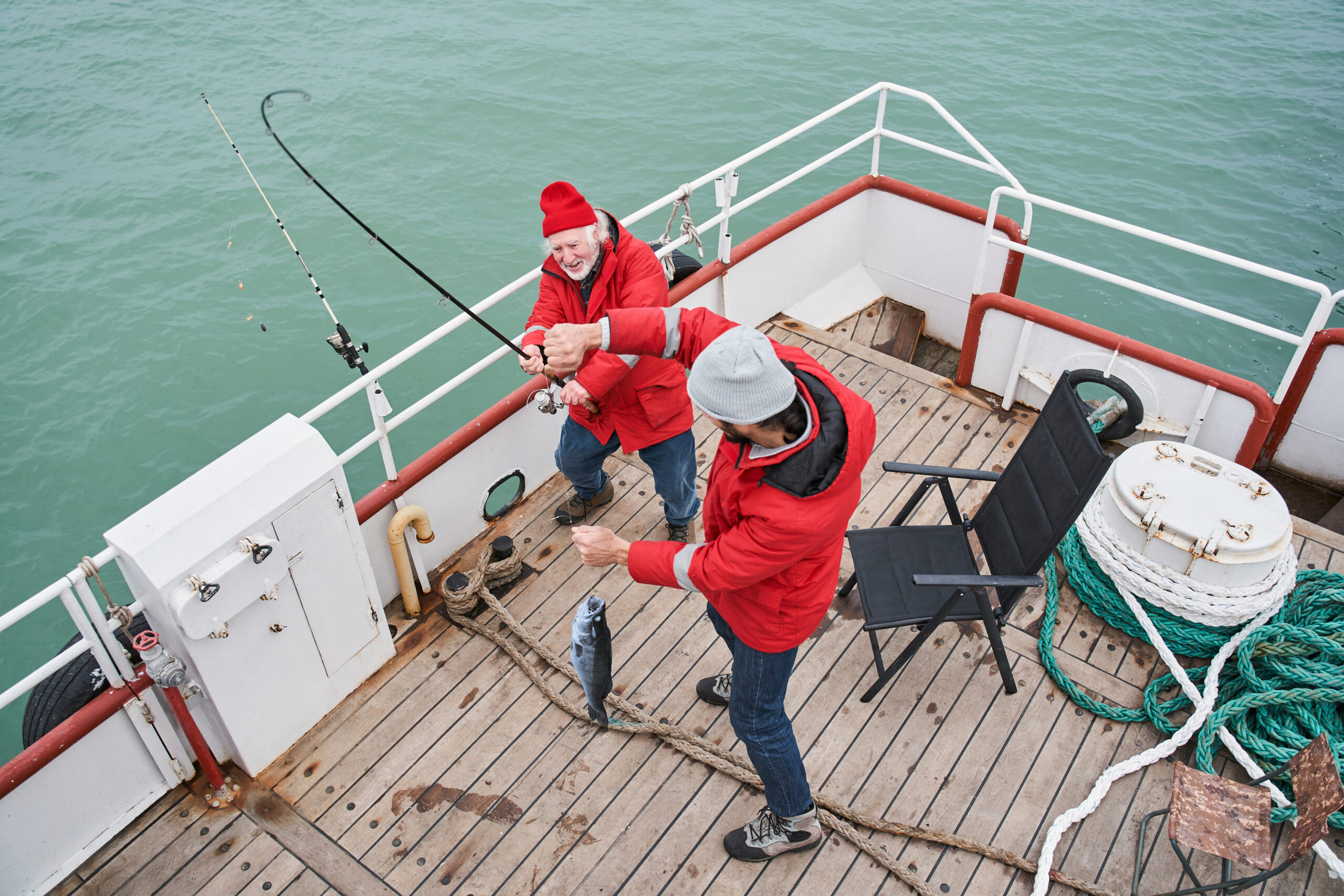What is every fisherman and woman’s goal on the water?
Catching Fish.
All the sunrises, sunsets, bait balls, riffles on the water, fish jumping, fins flashing, tail waving, heart-pumping excitement: all are extras. Ultimately, the fish caught and the fish to be caught drive the fisherman out for more over and over again.
Plain and simple.
For fishermen and women with fishing boats, the best way to keep catching fish a plain and simple endeavor is regularly using their boat. This guide covers a two-fold boat maintenance practice that will keep fishing boats reliable and in tip top shape.
One aspect of fishing boat maintenance is the care and maintenance recommended with every launch in and haul out of the water. The second aspect is the regular care and maintenance recommended at monthly, annual, or hours of use intervals. Below, these two aspects of fishing boat maintenance are laid out in a checklist format and discussed in greater detail.
Care and Maintenance recommended with every use in and out of the water:
Launching Checklist:
- Make sure the battery is charged and on.
- Make sure the drain plug is securely in place and/or all seacocks are in a closed position. *Inboard engines should have water intake open.
- Check fishing gear that is integral to the boat. If the boat has outriggers or downriggers, make sure the all mounting hardware is secure. Lines and release clips should be in good working order.
- Check Oil Level. Keep topped up. Do not overfill.
- Check Water Filter or Screen. Depending if you have an inboard engine or an outboard motor it is important to make sure your water filter or water screen is clean and free of any debris that could block water from freely entering your cooling system.
- Check Fuel level. It is best to always go out with a full fuel tank. Open fuel vent (if applicable).
- Check Fuel lines. Make sure all lines are in good condition, free of cracks. Further, make sure all fuel line connections are secure.
- Check Propeller/s. Propeller/s should be clean of any lines, dirt, or debris that could impede its spinning.
- Turn on electronics and bilge pumps, test VHF.
- Set out fresh garbage and recycling receptacles.
Haul out Checklist:
- Full freshwater whole boat washdown. Every fishing boat wants to bring in a commercial sized haul, but no one wants the commercial fishing boat smell. For this reason, a full freshwater washdown is arguably the single most important boat owner’s maintenance task. Ideally, every time the boat returns from a fishing mission, she gets a proper washdown.
- First, close all hatches and ports, remove topside cushions, wipe down, cover or remove electronics, and stow all belongings not integral to the boat before washing the boat. A good method is to wash the boat and all integrated fishing gear from top to bottom and front to back. Use a hose to wet the boat. Use a bucket filled with freshwater and mild boat soap, microfiber cloth/s, and brush scrubber/s to wipe and scrub the boat clean. Ultimately, make sure that all drains and crevices are clear of even the littlest bits of fishing line and debris so that water runs freely out of the boat.
- Clean coolers, cutting station, and live wells very well. Never use soap or unnecessary chemicals in a live well as bait are very sensitive. Diluting fresh water with white vinegar and hydrogen peroxide is a simple, natural, and effective cleaner to circulate through the live well. Always follow with fresh water only and circulate again.
- The final freshwater rinse should leave the fishing boat and all integral gear free of organic and inorganic matter that can cause damage, smell, or corrosion aboard. Remember many hands make light work. Enlist your crew.
- If the fishing boat is trailered, freshwater rinse the trailer after it comes out of the water and check lights before departing. When washing, pay close attention to getting wheels and brakes clean.
- Flush engine with freshwater as well, particularly when hauling out of saltwater and/or storing for any length of time.
- If the fishing boat has any interior space, wipe, clean, and dry interior before storing.
- Remove all food, waste and recycling.
Care and Maintenance required at monthly, annual, or hours-of-use intervals:
Engine Maintenance:
- Regularly open the engine cowling/s to inspect moving parts. Spraying and/or wiping down moving parts with an anti-corrosive will reduce the buildup of debris and keep your engine clean.
- The Engine Oil is responsible for lubricating all moving parts in an engine. Regularly changing this oil keeps an engine and all its moving parts running more smoothly. Change as recommended or every 100 hours. The seals and O-rings in an engine's lower unit keep the system watertight. When changing oil, inspect and/or change the seals and O-rings ensuring that system remains free of water intrusion.
- The water impeller located at the top of the lower unit is responsible for moving water and cooling outboard engines. Check manufacturers' recommendations for regular replacement guidelines. Typically, water impellers should be replaced annually or after every 100 hours of use.
- The Spark Plugs are located at the top of each cylinder and are responsible for the spark that ignites fuel in your engine system. Spark plugs should look clear of oil or gummed-up debris and should be gapped properly. Check spark plugs annually or after every 100 hours of use. Replace as needed or after every 300 hours of use.
Electronics Maintenance:
- Some navigational and specialty fish-finding electronics require updates. Check manufacturers' recommendations and stay up to date as directed.
- Annually, or as needed check wires and connections. Many boat owners nowadays are moving all connections out of wet places.
Fuel Maintenance:
- Depending on how long it will be before the next launch, the boat owner may or may not prefer to use a fuel stabilizer. Generally, the more a boat is used the fewer surprises, and the less a boat is used the more surprises. This is very true in the fuel department. If fuel is left to sit in a fuel tank for more than a month it is important to consider draining the fuel from the system or using a fuel stabilizer.
Pump Maintenance:
- Quarterly or as needed Check Bilge Pump/s and water pump/s regularly for good flow and remove any obstructions.
Battery Maintenance:
- Annually, check both terminals for corrosion. Clean as needed. Inspect box.
Fishing Gear Maintenance:
- Keep clean and rust free. Annually, loosen hardware to rinse parts and keep active. Be sure to retighten after cleaning.
- Annually or as needed, use a High-quality marine lubricant to keep any or all moving parts moving smoothly and quietly.
- If the fishing boat is equipped with outriggers or downriggers, annually check parts for sun damage, replace them as needed. Wax or polish aluminum rigger poles
- Regularly, make sure all clips and lines are running properly and well connected.
Trailer Maintenance:
- Regularly check tire pressure and tread for wear.
- See manufacturer's recommendations for greasing wheel bearings. Repacking every three to five seasons. Choose the right grease for the kind of water the trailer will go in and out of.
- Regularly check wiring and connections for function, corrosion, or damage. Clean or repair as needed. Trailer lights should always be operational.
- Regularly inspect winch, cable, straps and tie downs for any damage that may compromise their integrity and safe usage.
Boat Cover, canvas, and Window maintenance:
- For their longevity, boat covers, canvas, and windows should get some individual attention. They should each be washed with a cleaning product designed for the purpose of washing them specifically. The products will likely be of a different chemical makeup but the purpose for all is the same: to remove impurities and protect the material from mold, mildew and/or sun damage. Canvas and covers can be removed from their frames or cushions, washed, dried and replaced annually or as needed. Some boat owners wash their windows with each use some less frequently.
Stainless Maintenance:
- Many boat owners annually or bi-annually will use stainless specific products to thoroughly wash and polish their boats stainless. Doing this restores the original shiny look and lengthens the life of stainless. Elbow grease, toothbrushes and microfiber cloths are great tools for this job. Stainless cleaners can be dry powders that are mixed with water or wet and gel-like. Both work well and should be applied carefully. Follow with a freshwater rinse and towel dry.
Note: Stainless cleaners are strong and should not be allowed to sit on varnished brightwork. If stainless cleaner does get on brightwork, wash with a clean, wet cloth swiftly.
Check Safety Gear:
- Look over safety kits to be sure that emergency flares and medical kit items are well stocked and up to date.
- Check fire extinguishers are up to date.
- Check PFD’s. Make sure all clips and webbing are in good working order.
The most important job of a fishing boat is catching fish. By extension then, the most important job of a fishing boat captain and crew is keeping the boat well-maintained so that more fish can be caught. The maintenance program outlined above should keep fishing boats looking and performing as good as new.
The upside is that while making one's way through these checklists and certainly after, one has time to dream.
And what do every fisherman and woman dream about?
Catching the big one that got away.
Dreams can turn into nightmares when things happen that are out of our control. Accidents and unpredictable events can make great salty tales. They can also be anywhere from inconvenient to unnerving and scary. That’s what contingency plans are for. Ahoy! insurance can be your contingency plan.


